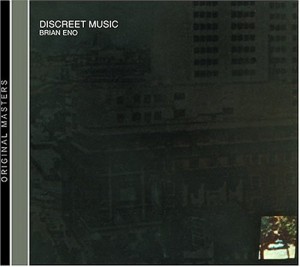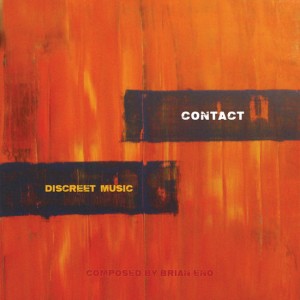Contact's Echoes Interview in the Echoes Podcast.
Podcast: Play in new window | Download
Subscribe: RSS
Listen to the Contact interview above, or download it from iTunes.
 Who ever thought 40 years ago that Brian Eno’s ambient works would find their way into the repertoire of performance groups? But that’s what has been happening over the last 20 years or so. Phillip Glass scored Eno’s collaborations with David Bowie for orchestra, the New York new music group, Bang on a Can All Stars covered Music for Airports, and the English new music group Icebreaker covered Apollo. Now, a Canadian ensemble called Contact has scored Eno’s Discreet Music for live instrumentalists. Jerry Pergolesi plays vibraphone and percussion with the group, and he scored Eno’s seemingly simple ambient work.
Who ever thought 40 years ago that Brian Eno’s ambient works would find their way into the repertoire of performance groups? But that’s what has been happening over the last 20 years or so. Phillip Glass scored Eno’s collaborations with David Bowie for orchestra, the New York new music group, Bang on a Can All Stars covered Music for Airports, and the English new music group Icebreaker covered Apollo. Now, a Canadian ensemble called Contact has scored Eno’s Discreet Music for live instrumentalists. Jerry Pergolesi plays vibraphone and percussion with the group, and he scored Eno’s seemingly simple ambient work.
In 1987, Brian Eno talked on Totally Wired about the ambient concepts that formed seminal albums like Music for Airports and Discreet Music. “Most of the ambient music is quite repetitive,” said Eno. “I’m relying on the notion that repetition is actually a way of pushing the listening mind onto details. Moving it away from certain aspects and pushing it onto smaller and smaller, more transitory details.”
Jerry Pergolesi realized Eno’s concepts even before he decided to reimagine Discreet Music for live instrumentalists. Pergolesi describes a transformative experience with Discreet Music. “I had to do a long drive after a gig late at night and I was going from somewhere in the middle of Michigan down to Detroit,” he recalls. “So I put on the original Discreet Music and just looped it over and over again. And I don’t remember the drive. I don’t remember a single thing about that drive. All I know is that the music would basically… I was just in it. And then I arrived at my destination, I was there.”
 Brian Eno recorded Discreet Music in 1975. Playing a couple of short melodic fragments on a synthesizer, he ran them through an equalizer, some echoes and into a tape machine. The tape from the first tape deck ran to the take-up reel of the second machine and the output of that deck is fed back into the first tape machine, which records the overlapped signal ad infinitum. It sounds simple and possibly a little boring, but instead it is a mesmerizing journey: A slow flow down a river of melodic invention.
Brian Eno recorded Discreet Music in 1975. Playing a couple of short melodic fragments on a synthesizer, he ran them through an equalizer, some echoes and into a tape machine. The tape from the first tape deck ran to the take-up reel of the second machine and the output of that deck is fed back into the first tape machine, which records the overlapped signal ad infinitum. It sounds simple and possibly a little boring, but instead it is a mesmerizing journey: A slow flow down a river of melodic invention.
Born in 1964, Jerry Pergolesi is a rocker turned new music exponent. He heads up Contact, the contemporary music ensemble in Canada. He didn’t start that way. He played in rock groups as a teenager, but his wasn’t your usual high school cover band.
“Back in the days of being in the rock band when we were just playing anything and everything,” he laughs. “We would do a set where we would cover “Larks Tongue in Aspic Part 2”, and then we would play a watered down version of some kind of derivative Tangerine Dream. Then we’d follow that by a cover of The Jam.”
In fact, Tangerine Dream’s “Phaedra” was the first ambient music Pergolesi heard. “I just remember hearing that and kinda going, ‘Oh my God.’ It was a light bulb moment for me.”
Eno famously once labeled himself a non-musician. On Discreet Music, with just a couple of melodic phrases played once and sent into the looping system, could be seen as anti musician.
“ Yeah, which I like about it,” says Pergolessi with a bit of a sinister tone. “It’s funny because I’ve tried playing along with some of our recordings on different instruments, and it’s pretty hard to get it right. I mean you can say, ‘Oh there’s not a lot of technical prowess involved,’ or whatever if you want. But there’s a completely different discipline to it. Just recently I took a course about minimalism with Russell Hartenberger. And he was talking about the early days with Glass and Reich, and he was talking about having to learn how to play with a different kind of discipline to play that music.”
Yeah, which I like about it,” says Pergolessi with a bit of a sinister tone. “It’s funny because I’ve tried playing along with some of our recordings on different instruments, and it’s pretty hard to get it right. I mean you can say, ‘Oh there’s not a lot of technical prowess involved,’ or whatever if you want. But there’s a completely different discipline to it. Just recently I took a course about minimalism with Russell Hartenberger. And he was talking about the early days with Glass and Reich, and he was talking about having to learn how to play with a different kind of discipline to play that music.”
Nevertheless, Discreet Music provided a particular challenge when Jerry Pergolesi transferred it to a nine-piece ensemble that included winds, strings, guitar and vibraphone. “It took some experimenting to figure out how do I make humans behave like a machine without it really seeming like they’re behaving like a machine,” he says, not without irony.
For all of that, there is a natural, one might say, human flow in the music from Contact’s nine musicians. “I struggled with that for a little bit,” he says, again, with a bit of irony. “As soon as I heard violinist Sarah [Fraser Raff] play with a little bit of vibrato, for instance, it freaked me out. I was like, ‘it’s not supposed to sound like that.’ And I didn’t know how to react to it, to be honest. And I got a lovely email from a group in Italy and it was [about] the emotion behind it. And I had never heard anyone describe Discreet Music in terms of emotion.”
Contacts’ rendition of Discreet Music isn’t a note for note transcription. The original version is thirty-one minutes long, but Contact plays it for a full sixty minutes. Pergolesi didn’t just double the work or slow it down, he actually rearranged it much in the manner of Terry Riley’s “in C.” That landmark minimalist work consists of a series of melodic fragments that are played by each musician for as long as they want before moving on to the next.
“I narrowed it down to the fragments that we have and then I used the band as a looping machine, so it’s through instructions as to how the band does it. And actually the recording that we’ve released is the third take in as many years, simply because it’s an off the floor recording. But it is a live recording, so when we started, that’s us playing for an hour.”
Pergolesi decided to adapt Brian Eno’s music about ten years ago after hearing Bang on a Can’s rendition of Eno’s Music for Airports. But for Contact’s first ambient recording, he chose Eno’s Discreet Music. Even after making the recording, Pergolesi went to Evan Ziporyn of Bang on a Can to see it he’d violated some sacred Eno principle.
“He said, basically when they did Music for Airports, they wanted to pay homage to the artifact of the recording,” explains Pergolesi. “Whereas when I showed him what my process for Discreet Music was, he said, ‘What you’re doing is paying homage to the process, because I think you’re doing the right thing here.’ So when he said that I was like ‘okay, fine, I can move on.’”
Jerry Pergolesi says he hasn’t heard from the composer yet, but an immersion into Contact’s Discreet Music reveals one of the guiding principles of Brian Eno.
“I want the notion of something that was steady state in the sense that it was always pretty much reliably similar but it was never exactly the same. “ said Eno in 1987. “ A little bit like any natural process, you know like watching a river or something like that where it doesn’t pull many really big surprises on you, but at the same time it never repeats itself perfectly. So I wanted to make some music that had rather homogeneous but ever changing character to it.”
You can float down the ambient river of Contact’s Discreet Music, released on The Cantaloupe label.
